Ibeji statue, Nigeria
Wood, beads, plant fibers, pigments
H. 32 cm
Provenance :
Bernd Muhlack Collection, Germany
The great diversity of Yoruba statuettes representing twins, known in Nigeria as ere (image) ibeji (twin), is extraordinary. William Fagg noted and referenced this in his early investigations, which focused on thousands of ibeji figures discovered first in Yoruba territory, before turning his attention to those held in private collections.
As Rowland Abiodun (1975- 1883-1987) has clearly demonstrated, the Yoruba developed a particularly elaborate aesthetic language. The history and role of these statuettes of twins must be fully understood and appreciated if we are to grasp their plastic qualities.
For the Yoruba, twins are considered gifts from heaven, possessing a unique and inseparable soul, they are an entity and synonymous with good fortune. If one of the twins were to die, a wooden statuette would immediately be carved to "replace" the deceased twin, to offset the danger of imbalance threatening the soul of the surviving twin. The statuette would then appear to embody the soul of the deceased twin.
Carved with particular care to reflect their profound essence and powerful symbolism, ibeji are placed in clean calabashes and leaned against the wall inside the twin's home. Dressed and washed as if the twin were still alive, they are coated with oil to make them shine, the care lavished on them demonstrates the love linked to the departed soul reincarnated in the statuette's guise. Commissioned to represent a soul, a spirit, as such they demand to be loved, cherished, honored and respected. They bring hope, prosperity, blessings and continuity. Small in size, they are easy to hold, transport, venerate, constantly use and handle.
"The fact that an object is used in no way detracts from its quality as a work of art or a subject of artistic appreciation and admiration." (George Chemeche, Ibeji, Le culte des jumeaux Yoruba, 2003, p.19).
The shiny light-brown patina with its honey tones is matched by the softness of its refined, supple lines. A rhythm is imparted by the meticulous treatment of each of its angular extremities, so that the chin, breasts, umbilicus and bent knees respond to each other, creating a dynamic profile that enlivens the statuette.
The graceful neck, foreshadowing the face with its deep brown patina and features blurred by time and the repeated use of caresses received and care faithfully lavished. Her sophisticated conical hairstyle, finely streaked with indigo blue pigments, has stood the test of time. A living testimony, it bears the visible marks of all the ritual attention and regular affection bestowed on it from generation to generation through its faded features, its beautiful shiny patina, and rich residues of white pigments, maintained on the shoulders, upper chest and feet.
Despite her small size, she exudes power and presence. Monumental without being gigantic, she's expressive without being outrageous.
Ibeji statue, Nigeria
Wood, beads, plant fibers, pigments
H. 32 cm
Provenance :
Bernd Muhlack Collection, Germany
The great diversity of Yoruba statuettes representing twins, known in Nigeria as ere (image) ibeji (twin), is extraordinary. William Fagg noted and referenced this in his early investigations, which focused on thousands of ibeji figures discovered first in Yoruba territory, before turning his attention to those held in private collections.
As Rowland Abiodun (1975- 1883-1987) has clearly demonstrated, the Yoruba developed a particularly elaborate aesthetic language. The history and role of these statuettes of twins must be fully understood and appreciated if we are to grasp their plastic qualities.
For the Yoruba, twins are considered gifts from heaven, possessing a unique and inseparable soul, they are an entity and synonymous with good fortune. If one of the twins were to die, a wooden statuette would immediately be carved to "replace" the deceased twin, to offset the danger of imbalance threatening the soul of the surviving twin. The statuette would then appear to embody the soul of the deceased twin.
Carved with particular care to reflect their profound essence and powerful symbolism, ibeji are placed in clean calabashes and leaned against the wall inside the twin's home. Dressed and washed as if the twin were still alive, they are coated with oil to make them shine, the care lavished on them demonstrates the love linked to the departed soul reincarnated in the statuette's guise. Commissioned to represent a soul, a spirit, as such they demand to be loved, cherished, honored and respected. They bring hope, prosperity, blessings and continuity. Small in size, they are easy to hold, transport, venerate, constantly use and handle.
"The fact that an object is used in no way detracts from its quality as a work of art or a subject of artistic appreciation and admiration." (George Chemeche, Ibeji, Le culte des jumeaux Yoruba, 2003, p.19).
The shiny light-brown patina with its honey tones is matched by the softness of its refined, supple lines. A rhythm is imparted by the meticulous treatment of each of its angular extremities, so that the chin, breasts, umbilicus and bent knees respond to each other, creating a dynamic profile that enlivens the statuette.
The graceful neck, foreshadowing the face with its deep brown patina and features blurred by time and the repeated use of caresses received and care faithfully lavished. Her sophisticated conical hairstyle, finely streaked with indigo blue pigments, has stood the test of time. A living testimony, it bears the visible marks of all the ritual attention and regular affection bestowed on it from generation to generation through its faded features, its beautiful shiny patina, and rich residues of white pigments, maintained on the shoulders, upper chest and feet.
Despite her small size, she exudes power and presence. Monumental without being gigantic, she's expressive without being outrageous.

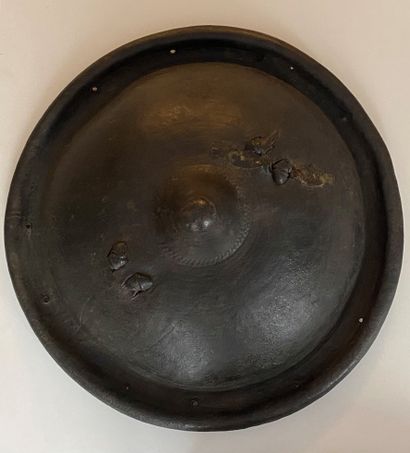

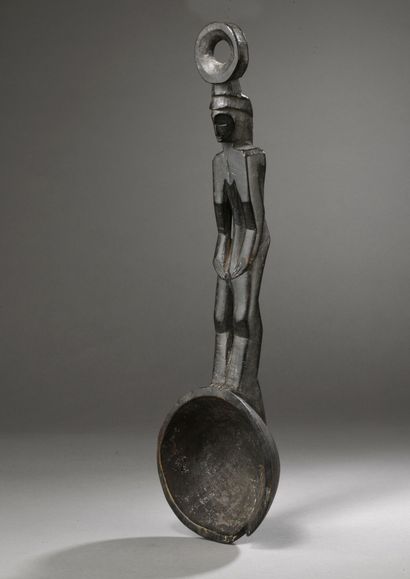


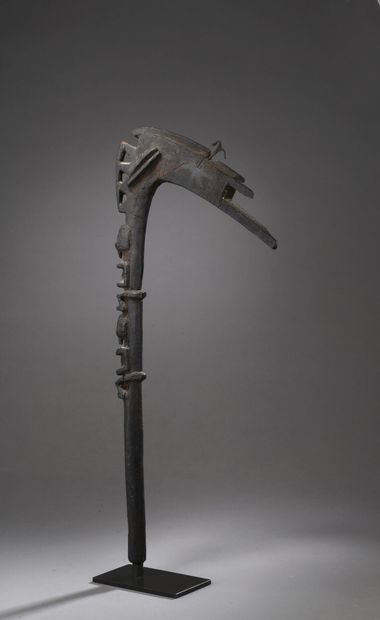

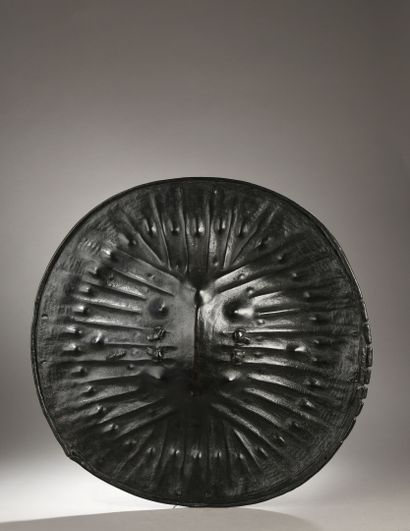
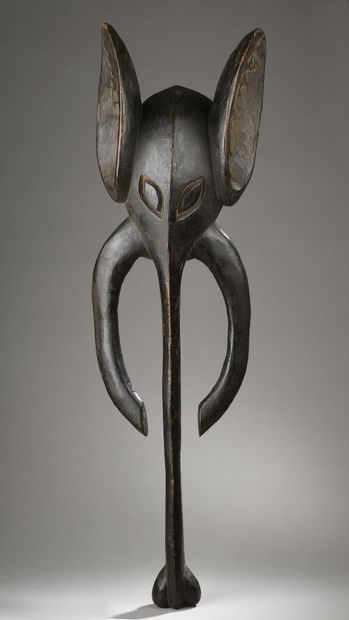

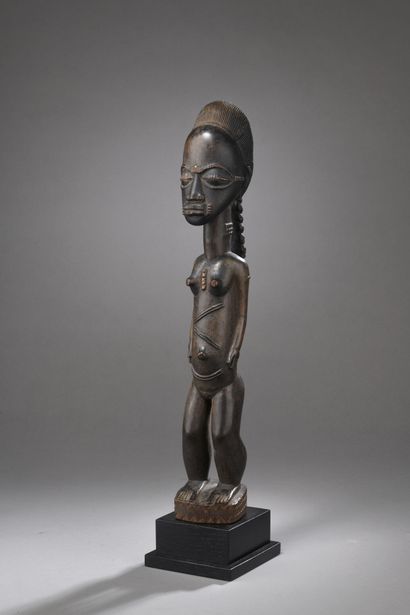


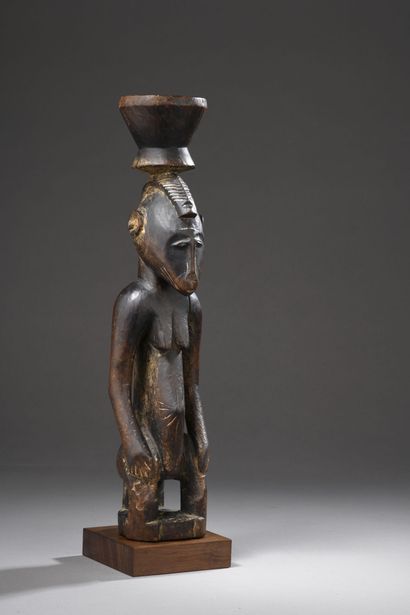
Testen Sie LotSearch und seine Premium-Features 7 Tage - ohne Kosten!
Lassen Sie sich automatisch über neue Objekte in kommenden Auktionen benachrichtigen.
Suchauftrag anlegen